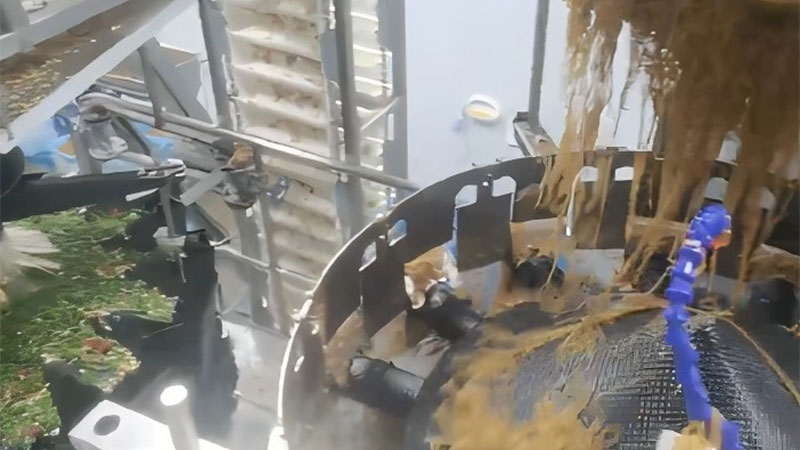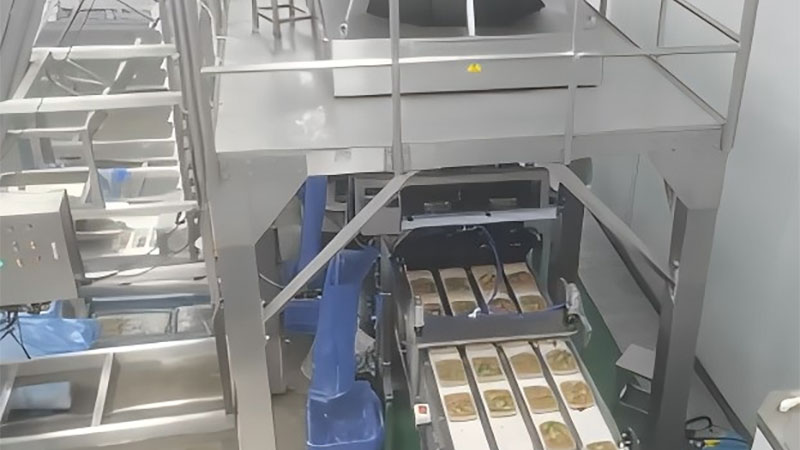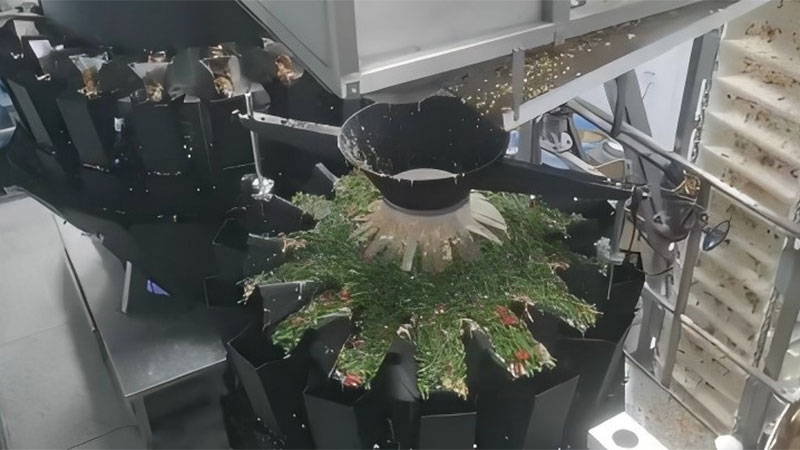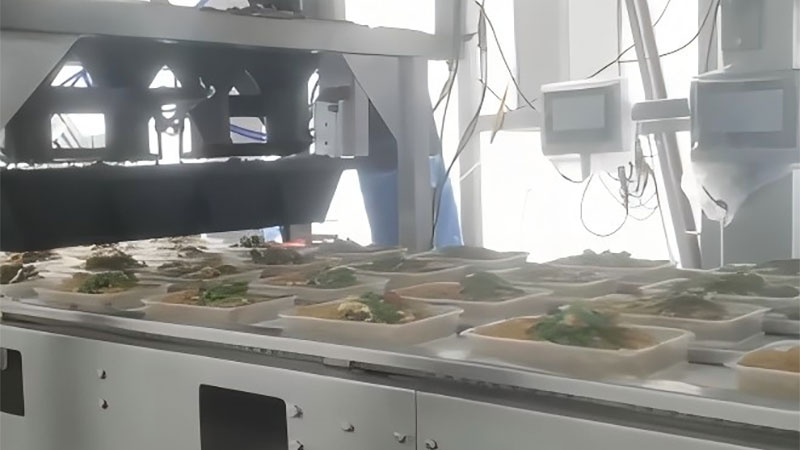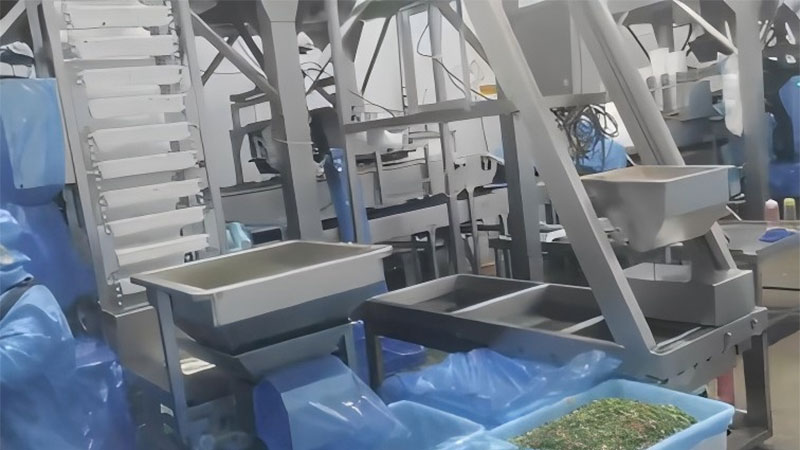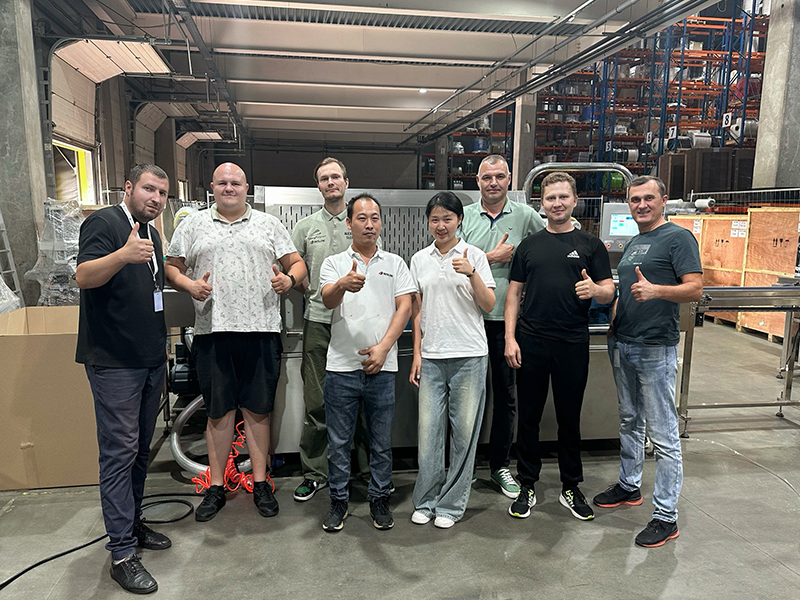Fried Noodles
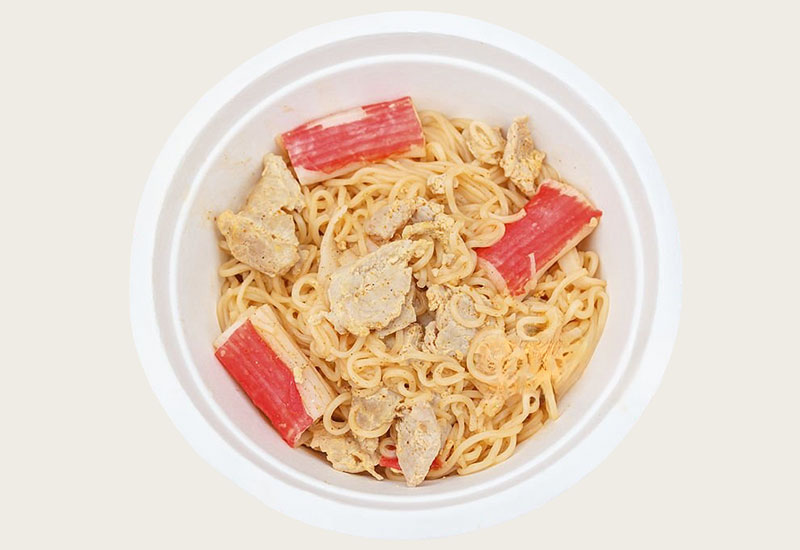
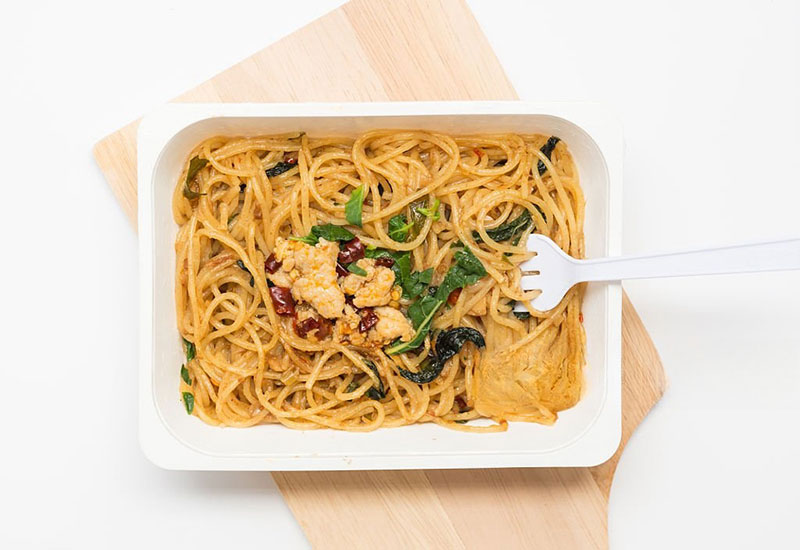
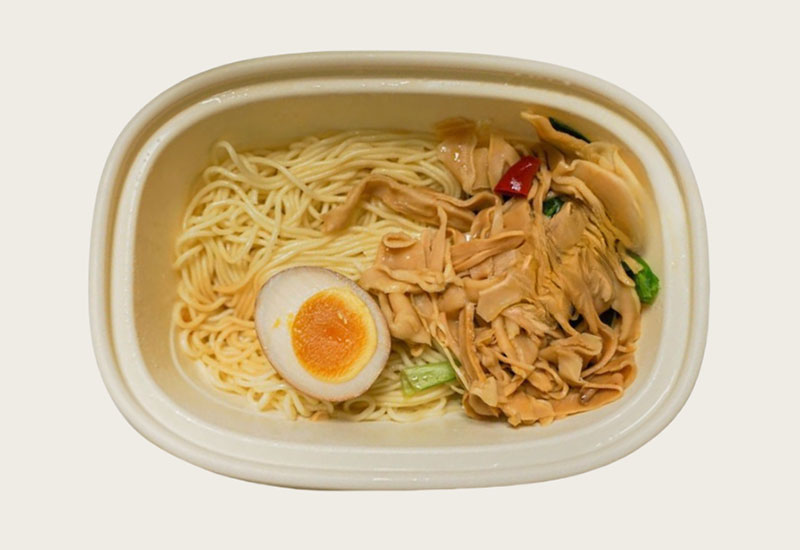
Fully Automated Tray-Packaged Fried Noodles Production Line
Background
1.Overview
Pre-prepared meals reflect the fast-paced modern lifestyle and have increasingly gained favor among consumers. These foods offer convenience and speed while ensuring high quality and safety. The European market places a strong emphasis on food quality and innovation, with high-end customers having stringent requirements for both product quality and service. Traditional food packaging equipment has limitations in adapting to diverse product varieties, high production capacities, and rapid changeovers, thus creating significant market opportunities for automated and intelligent food packaging equipment.
In March 2022, the Resure team successfully implemented a ready-to-eat food packaging project. The client is a company that produces ready-to-eat fried noodles, primarily supplying supermarkets and convenience stores. To enhance their market competitiveness, the client plans to upgrade their packaging line to achieve production automation while meeting food safety standards. The main focus of this project is on precise portioning, fast packaging, and ensuring seal quality.
2.Client Requirements and Pain Points
- Precise Portioning: Fried noodles tend to be light and fluffy, which can lead to weighing errors. A high-precision measuring system is required to ensure accuracy in portioning.
- Fast Sealing: To meet high-volume production demands, the packaging process must be fast, improving packaging efficiency per minute.
- Food Freshness and Safety: It is essential to ensure tight seals to prevent package damage during transportation or storage, thus maintaining product freshness and safety.
- Compatibility with Eco-friendly Materials: The client prefers to use biodegradable or environmentally friendly packaging bags, so the equipment must be compatible with a variety of materials.
- Reduce Manual Operations: The client seeks to reduce labor input by achieving full automation in the packaging process, enhancing both production efficiency and stability.
Solution Design
1. Overview
The project aims to build a fully automated fried noodle packaging production line that accurately portions stir-fried noodles into trays and completes the sealing process. The solution achieves high-efficiency and stable production through a highly automated system, preventing product contamination or loss, ensuring the seal integrity and freshness of the food in the trays, and meeting the packaging standards of retail channels and e-commerce platforms. The equipment must be compatible with eco-friendly tray materials and allow flexible adjustments to accommodate different tray sizes.
To achieve this goal, the entire production line adopts a modular design, including tray feeding, weighing, portioning, sealing, inspection, labeling, and other stages. The line is equipped with an intelligent control system to ensure efficient collaboration of the equipment, enhancing the overall automation level of the production line.
| Packaging Process | Designed to meet production capacity requirements, the line features a continuous four-station chain and pusher mixed packaging system. |
| Tray Dimensions | Tray: 187 x 137 mm (height: 30-50 mm) Bowl: 150 mm (height: 35-55 mm) |
| Temperature | 3℃-60℃ |
2. Equipment Structure
(1)Automatic Tray Dropping Device
- Automatic tray dropping: Automatically retrieves trays from a stacked pile and accurately places them at the designated workstation.
- Tray positioning: Ensures that trays are precisely aligned on the conveyor belt with subsequent filling stages.
(2)Multihead Weigher Accurate Weight Automatic Loading and Unloading System
- Multiheadweigher : Achieves high-precision weighing for fried noodles, addressing their loose and airy characteristics.
- Automatic feeding system: Utilizes vibration feeding to prevent material clogging and ensure smooth material flow during portioning.
(3)Tray Gripper Feeding Device
- Automatic gripper transport: Ensures stable tray transport and precise alignment at each station on the conveyor belt.
(4)Measuring Cup Solid Filling Machine
- Precise portioning of ingredients: Uses a measuringcup to accurately control the amount of mixed vegetables (e.g., shredded carrots, diced onions, beetroot, corn kernels, mushroom strips, etc.) per tray, ensuring consistency in product specifications.
(5)Measuring Cup Liquid Filling Machine
- Sauce or seasoning filling: Features a leak-proof design to ensure liquid ingredients are accurately dispensed into trays.
- Multi-specification compatibility: Supports various liquid formulas and capacities for different types of fillings.
(6)Counting Automatic Loading and Unloading Device
- Ingredient portioning and counting: Used to precisely place ingredients like meatballs, patties, boiled eggs, or fried eggs, ensuring consistent portioning across trays.
(7)Tray Sealing Machine
- Automatic film covering and heat sealing: Automatically covers the trays with sealing film and applies heat sealing.
- MAP (Modified Atmosphere Packaging) Module: Optional nitrogen or other gas flushing to extend the shelf life of the product.
(8)Weight Checker
- Finished product weight detection: Ensures that each tray meets the required weight specifications. Non-compliant products will be automatically rejected.
(9)Metal Detector
- Metal contaminant detection: Scans trays for any metal foreign objects, ensuring food safety.
(10)Flat Labeling Machine
- Automatic Labeling on Sealing Film: Labels the sealing film with production dates, batch numbers, and barcodes for traceability and product management.
In this section, various liquids and pastes are filled, along with the placement of irregularly shaped and countable items such as small patties and meatballs. This is followed by vacuum sealing, gas flushing, sealing, and secondary sealing reinforcement. After sealing, the trays are pushed onto the conveyor belt and sent to the weighing machine. If any products are underweight, the system will automatically reject them.
3. Automation Level
- PLC System Control: All equipment is interconnected and controlled by a centralized PLC system, ensuring smooth operation across the entire production line.
- HMI Touchscreen Interface: Operators can monitor equipment status, adjust parameters, and view production data directly on the interface, providing easy access for real-time control.
- Intelligent Alarm System: In the event of abnormalities in weight, sealing, or ingredient portioning, the system will automatically stop the line and alert the operator with a fault message.
- Production Data Traceability and Export: Supports the traceability and analysis of production data, including batch numbers and inspection results, for quality control and reporting purposes.
4. Design drawing
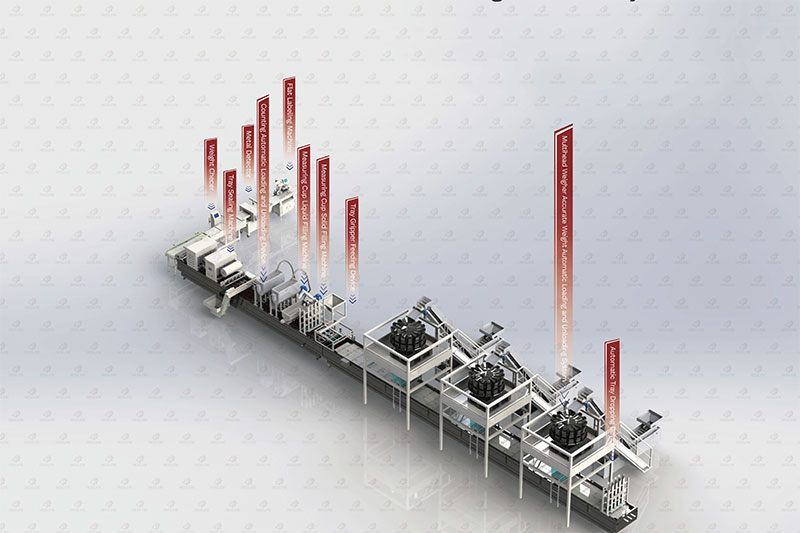
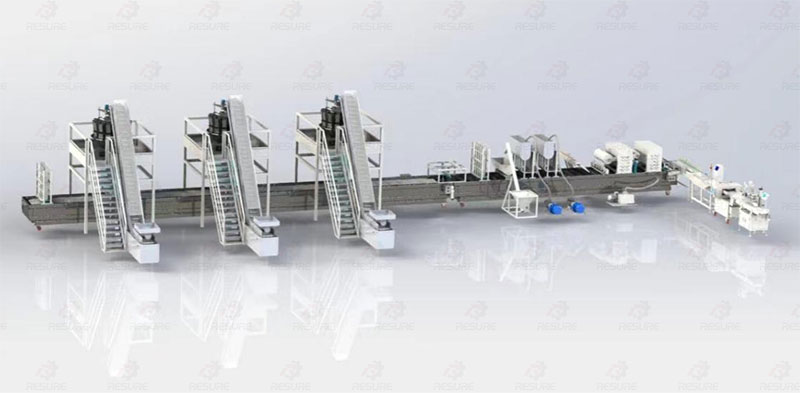
Practical Application
Product Ingredients: Fried noodles, cooked meat cubes, boiled vegetable mix.


